[Editor’s Note: Regular readers of the Mad Scientist Laboratory are familiar with a number of disruptive trends and their individual and convergent impacts on the Future Operational Environment (OE). In today’s post, we explore three recent publications to expand our understanding of these and additional emergent global trends. We also solicit your input on any other trends that have the potential to transform the OE and change the character of future warfare.]
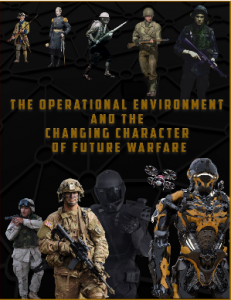 “The U.S. Army finds itself at a historical inflection point, where disparate, yet related elements of the Operational Environment (OE) are converging, creating a situation where fast-moving trends across the Diplomatic, Information, Military, and Economic (DIME) spheres are rapidly transforming the nature of all aspects of society and human life – including the character of warfare.” — The Operational Environment and the Changing Character of Future Warfare
“The U.S. Army finds itself at a historical inflection point, where disparate, yet related elements of the Operational Environment (OE) are converging, creating a situation where fast-moving trends across the Diplomatic, Information, Military, and Economic (DIME) spheres are rapidly transforming the nature of all aspects of society and human life – including the character of warfare.” — The Operational Environment and the Changing Character of Future Warfare
Last year, the Mad Scientist Initiative published several products that envisioned these fast-moving trends and how they are transforming the Future OE. These products included our:
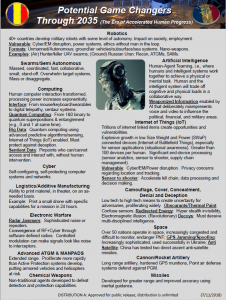 • Updated Potential Game Changers information sheet, identifying a host of innovative technologies with the potential to disrupt future warfare during The Era of Accelerated Human Progress (now through 2035) and The Era of Contested Equality (2035 through 2050).
• Updated Potential Game Changers information sheet, identifying a host of innovative technologies with the potential to disrupt future warfare during The Era of Accelerated Human Progress (now through 2035) and The Era of Contested Equality (2035 through 2050).
 • Black Swans and Pink Flamingos blog post, addressing both Black Swan events (i.e., unknown, unknowns) which, though not likely, might have significant impacts on how we think about warfighting and security; and Pink Flamingos, which are the known, knowns that are often discussed, but ignored by Leaders trapped by organizational cultures and rigid bureaucratic decision-making structures.
• Black Swans and Pink Flamingos blog post, addressing both Black Swan events (i.e., unknown, unknowns) which, though not likely, might have significant impacts on how we think about warfighting and security; and Pink Flamingos, which are the known, knowns that are often discussed, but ignored by Leaders trapped by organizational cultures and rigid bureaucratic decision-making structures.
With the advent of 2019, three new predictive publications have both confirmed and expanded the Mad Scientist Initiative’s understanding of emergent trends and technologies:
• Government Accounting Office (GAO) Report to Congressional Committees: National Security Long Range Emerging Threats Facing the United States As Identified by Federal Agencies, December 2018
• Deloitte Insights Technology, Media, and Telecommunications Predictions 2019, January 2019
• World Economic Forum (WEF) The Global Risks Report 2019, 14th Edition, January 2019
Commonalities:
These three publications collectively confirmed Mad Scientist’s thoughts regarding the disruptive potential of Artificial Intelligence (AI), Quantum Computing, the Internet of Things (IoT), and Big Data; and individually echoed our concerns regarding Cyber, Additive Manufacturing, Space and Counterspace, Natural Disasters, and the continuing threat of Weapons of Mass Destruction. That said, the real value of these (and other) predictions is in informing us about the trends we might have missed, and expanding our understanding of those that we were already tracking.
New Insights:
From the GAO Report we learned: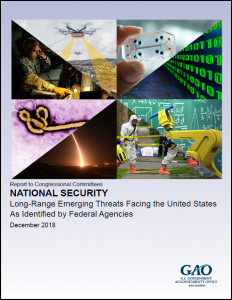
Megacorporations as adversaries. Our list of potential adversaries must expand to include “large companies that have the financial resources and a power base to exert influence on par with or exceeding non-state actors.” Think super-empowered individual(s) enhanced further by the wealth, reach, influence, and cover afforded by a transnational corporation.
“The rich population is shrinking, the poor population is not. Working-age populations are shrinking in wealthy countries and in China and Russia, and are growing in developing, poorer countries…. [with] the potential to increase economic, employment, urbanization and welfare pressures, and spur migration.”
“Climate change, environment, and health issues will demand attention. More extreme weather, water and soil stress, and food insecurity will disrupt societies. Sea-level rise, ocean acidification, glacial melt, and pollution will change living patterns. Tensions over climate change will grow.”
“Internal and International Migration. Governments in megacities … may not have the capacity to provide adequate resources and infrastructure…. Mass migration events may occur and threaten regional stability, undermine governments, and strain U.S. military and civilian responses.”
“Infectious Diseases. New and evolving diseases from the natural environment—exacerbated by changes in climate, the movement of people into cities, and global trade and travel—may become a
pandemic. Drug-resistant forms of diseases previously considered treatable could become widespread again…. Diminishing permafrost could expand habitats for pathogens that cause disease.”
 From Deloitte Insights Predictions we learned:
From Deloitte Insights Predictions we learned:
Intuitive AI development services may not require specialized knowledge. “Baidu recently released an AI training platform called EZDL that requires no coding experience and works even with small data training sets…. Cloud providers have developed pre-built machine learning APIs [application-programming interfaces] for technologies such as natural language processing that customers can access instead of building their own.”
Cryptocurrency growth may have driven Chinese semiconductor innovation. Chinese chipmakers’ Application-Specific Integrated Circuits (ASICs), initially designed to meet domestic bitmining demands, may also meet China’s growing demand for AI chipsets vice Graphics Processing Units (GPUs). “Not only could these activities spark more domestic innovation… China just might be positioned to have a larger impact on the next generation of cognitive technologies.”
“Quantum-safe security was important yesterday. Malicious adversaries could store classically encrypted information today to decrypt in the future using a QC [Quantum Computer], in a gambit known as a ‘harvest-and-decrypt’ attack.”
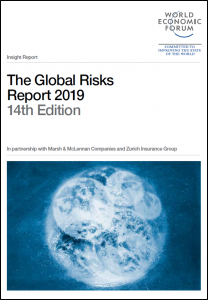 From the WEF Report we learned:
From the WEF Report we learned:
“This is an increasingly anxious, unhappy, and lonely world. Anger is increasing and empathy appears to be in short supply…. Depression and anxiety disorders increased [globally] between 1990 and 2013…. It is not difficult to imagine such emotional and psychological disruptions having serious diplomatic—and perhaps even military—consequences.”
The risk from biological pathogens is increasing. “Outbreaks since 2000 have been described as a ‘rollcall of near-miss catastrophes’” and they are on the rise. “Biological weapons still have attractions for malicious non-state actors…. it [is] difficult to reliably attribute a biological attack… the direct effects—fatalities and injuries—would be compounded by potentially grave societal and political disruption.”
“Use of weather manipulation tools stokes geopolitical tensions. Could be used to disrupt … agriculture or military planning… if states decided unilaterally to use more radical geo-engineering technologies, it could trigger dramatic climatic disruptions.”
“Food supply disruption emerges as a tool as geo-economic tensions intensify. Worsening trade wars might spill over into high-stakes threats to disrupt food or agricultural supplies…. Could lead to disruptions of domestic and cross-border flows of food. At the extreme, state or non-state actors could target the crops of an adversary state… with a clandestine biological attack.”
Taps run dry on Water Day Zero. “Population growth, migration, industrialization, climate change, drought, groundwater depletion, weak infrastructure, and poor urban planning” all stress megacities’ ability to meet burgeoning demands, further exacerbating existing urban / rural divides, and could potentially lead to conflicts over remaining supply sources.
What Are We Missing?
The aforementioned trends are by no means comprehensive. Mad Scientist invites our readers to assist us in identifying any other additional emergent global trends that will potentially transform the OE and change the character of future warfare. Please share them with us and our readers by scrolling down to the bottom of this post to the “Leave a Reply” section, entering them in the Comment Box with an accompanying rationale, and then selecting the “Post Comment” button. Thank you in advance for all of your submissions!
If you enjoyed reading these assessments about future trends, please also see the Statement for the Record: Worldwide Threat Assessment of the US Intelligence Community, 29 January 2019, from the U.S. Senate Select Committee on Intelligence.

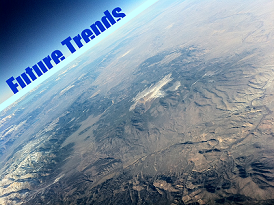


Comment received from Dr. Nir Buras via email:
“This blog post is pretty comprehensive, but aside from a few technical details/innovations that didn’t exist at the time, echo Jim Dator and Clem Bezold’s (Institute for Alternative Futures) long-time predictions.
In the face of being accused of self-promotion, may I suggest that you add the Futurist Scenarios blog I contributed to this one? It’s purpose was to add a more general perspective on the overall outcomes and a dimension of probability to the foresight.
[see: https://madsciblog.tradoc.army.mil/116-three-futurist-urban-scenarios/%5D
I also wonder about OE. There must be some people who wonder about all the equipment and gadgets we are loading on soldiers. In my day we worked with far less, and I find it personally hard to imagine schlepping all that stuff around all the time. But then I am no brawny dude.
In my day we were amazed at the soldiering capacity of Palestinian and especially Syrian fighters, who in many cases were equipped with even less than us. I also wonder about how a soldier, stripped of most of the equipment, could fend for themselves – or be operationally more effective, just by virtue of having more mobility. No need to give the example of the Viet Cong.
It is a balancing act. For one, it is a fact that we always start out a war by fighting the previous one. The other thing is that tactics have always been choreographed based on traditions passed down generationally. An example is the lines of soldiers shooting at each other in the American Civil War, and the trench stalemates of WWI.
But then I am no expert. Perhaps we need something in addition to imagining future conflict now and inventing solutions to it based on what we know NOW. Perhaps we need as well a strategy whereby invention and production are designed for rapid deployment DURING a conflict, producing gear interactively with people in the field specific to the conditions IN REAL TIME? Sort of an inventors lab attached to small(er) units? Is there something like that? Or training for improvisation alongside combat training?”
Thanks for article.